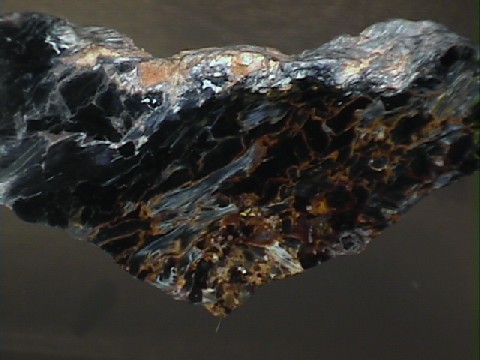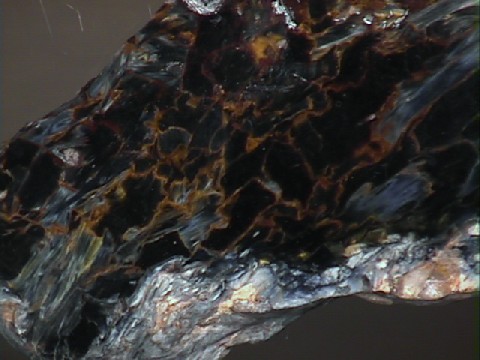 The Mineral RIEBECKITE
The Mineral RIEBECKITE
- Chemistry: Na2(Fe, Mg)3Fe2Si8O22(OH)2 , Sodium Iron Magnesium Silicate Hydroxide.
- Class: Silicates
- Subclass: Inosilicates
- Group: Amphibole
- Uses: As asbestos and as mineral specimens.
Specimens
Riebeckite is not a well known mineral although most people have probably seen stones that at one time were composed of riebeckite crystals. The typically dark blue mineral was named after a famous eighteenth century German explorer and minerologist, Emil Riebeck. Riebeckite is an important mineral for two main reasons: one for when it is there and one for when it isn't.
First, some forms of riebeckite are asbestiform and can be used as asbestos. Asbestos has many industrial uses despite some health risks and is made of different minerals all with a fibrous habit. Serpentine and tremolite form most of the asbestos that is used for industrial purposes. But riebeckite has a variety called "crocidolite" that is asbestiform in habit and is a significant percentage of the total tonage of asbestos that is mined annually. The largest deposit of crocidolite occurs in South Africa and is mined there in large quantities. A second deposit in Australia is significantly smaller but is still productive. Crocidolite is also known as "blue asbestos" and "riebeckite asbestos".
Secondly, crocidolite is often found pseudomorphed by quartz into an attractive ornamental stone. The stone is extremely popular as a semi-precious stone and is known by many trade names such as Tiger's Eye, Hawk's Eye, Falcon's Eye, etc. A pseudomorph is an atom by atom replacement of one mineral for another, without significant destruction of the original mineral's outward shape. The pseudomorphing of riebeckite's asbestos fibers does two things; it preserves the beauty of the fibers and their lustrous light effects and it produces a much more durable stone that is now, thanks to the silicification, suitable for carving and jewelry. Blue tiger's eye has preserved the original blue color of the riebeckite while the more common brown color is the result of some oxidation of the iron into limonite inclusions. Although it is improper to refer to tiger's eye as being a form of riebeckite because there is no riebeckite present in the stone, credit must be given to this mineral for the aid in producing this wonderfully beautiful ornamental stone.
The chemistry of riebeckite is odd in that it includes two different iron atoms. One is ferric (with a plus 3 charge) and one is ferrous (with a plus 2 charge). The ferrous iron occupies the same position as and substitutes with the plus 2 manganese because both ions are of nearly the same size. The formula is written the way it is to show the different iron ions.
Riebeckite is a part of several solid solution series. A solid solution
series is where two or more elements can substitute for each other without
changing the structure of the mineral. In the case of riebeckite, there
exists two such series. The easiest to explain series exists with a mineral
called
The other solid solution series is incomplete, meaning there are gaps
in the percentages between the minerals. The other members of this series
include one that is much more well know than magnesioriebeckite and one
that is almost as obscure. The common mineral is glaucophane
and its formula is Na2(Mg, Fe)3Al2Si8O22(OH)2.
Glaucophane is the magnesium and aluminum rich member and riebeckite is
the ferrous and ferric iron rich member. The obscure mineral
|
FERROUS IRON [Fe(+2)] RICH |
MAGNESIUM (Mg) RICH |
|
|
FERRIC IRON [Fe(+3)] RICH |
RIEBECKITE Na2Fe(+2)3Fe(+3)2Si8O22(OH)2 |
MAGNESIORIEBECKITE Na2Mg3Fe(+3)2Si8O22(OH)2 |
|
intermediate |
none defined |
CROSSITE Na2(Mg, Fe(+2))3(Fe(+3), Al)2Si8O22(OH)2 |
|
ALUMINUM (Al) RICH |
FERROGLAUCOPHANE Na2Fe(+2)3Al2Si8O22(OH)2 |
GLAUCOPHANE Na2Mg3Al2Si8O22(OH)2 |
All the members of this series have the same structure and similar properties. However, with a increase in iron percentages the color darkens, the streak is bluer, the density increases and the luster increases. Riebeckite is found in alkaline granites, syenites, schists and metamorphosed banded iron formations (BIF). Its presence in igneous rocks is quite different from glaucophane which is restricted for some reason to metamorphic rocks. Asbestos riebeckite is only found in metamorphic rocks, however.
PHYSICAL CHARACTERISTICS:
- Color is usually dark blue to black.
- Luster is vitreous or silky in fibrous forms.
- Transparency: Crystals are translucent.
- Crystal System is monoclinic; 2/m.
- Crystal Habits include slender prismatic to acicular, often aggregated crystals, columnar, granular and fibrous, asbestiform masses. A moss-like aggregate habit has been described when found in some igneous rocks.
- Cleavage: is perfect in two directions at 56 and 124 degree angles.
- Fracture is splintery to uneven.
- Hardness is 5 - 6.
- Specific Gravity is approximately 3.2 - 3.4 (average to slightly above average).
- Streak is blue-gray.
- Other Characteristics: Weakly pleochroic and crystals are striated lengthwise.
- Associated Minerals are nepheline, quartz, almandine, aegirine, feldspars, micas and hematite.
- Notable Occurrences include Socotra Island, South Yemen; Transvaal, South Africa; Schirmeck, Germany; Langesund, Norway; Krivoi Rog, Ukraine; Hamersley Range in Western Australia; Scotland; Madagascar; Quincy, Massachusetts; St Peter's Dome, El Paso County, Colorado; California; Oregon and Cumberland Hill, Rhode Island, USA.
- Best Field Indicators are crystal habit, color, streak, cleavage and hardness.



